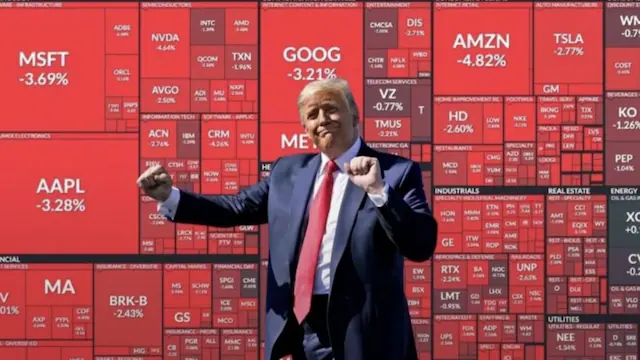Trump’s Tariffs On Global Market: Earlier this month, on the 2nd of April 2025, the recently elected US President Donald Trump announced a steep hike in the tariffs on all countries. The average effective tariff rate was determined as 23%, which is almost 10 times what it was in the past. The announcement from Trump triggered a major selloff in the global financial markets, impacting assets like gold and bitcoin as well. Although he paused the tariffs on all countries (except China) on April 9 and imposed a base 10% tax on all, the impact on global markets was severe. If you are someone who wants to understand the impact of Trump’s tariffs on the global markets, this article is for you.
Trillions Of Global Equity Value Wiped Off
The announcement of Trump’s tariffs on all countries triggered a steep fall in the global markets, with almost all countries witnessing major selloffs. The red bath of Wall Street on April 7, which was also called a Black Monday by many, wiped off trillions of global equity value in a span of a few hours. US benchmarks like the S&P 500 as well as the Nasdaq-100 actually witnessed steep falls of over 4.3% and 5.4%, respectively. Global markets like China, Japan, India, and Taiwan were also significantly impacted. As of now, the stock market has recovered at the slightest, however, market volatility and uncertainty surrounding the tariffs continue to affect trade.
Also read : China Halts Liquefied Gas Imports from the US – Key Reasons & Impact
Impact Of Trump Tariffs On Oil, Gold, And Cryptocurrency
The impact of the Trump tariffs wasn’t limited only to the equity market but also affected assets like gold and cryptocurrency. Gold, which is usually considered a safety net during uncertainty, saw an increase in demand. The global Gold markets reported a record high of $3,167 per ounce. The April 7 crash brought it down to $2,977 before it settled on $2,984. On the other hand, oil prices witnessed a 9% fall after the tariff announcement, dropping below $57, definitely the lowest since 2021. Cryptocurrency also joined the red bath with Bitcoin plunging over 30% since Trump took office. Other popular cryptos like Ethereum, XRP, Solana, and Dogecoin plunged 15% within hours.
Retaliatory Tariffs Imposition On the USA
Many countries, especially China, reacted to the tariff imposition with the imposition of retaliatory tariffs. This resulted in a further escalation in the trade war. China imposed an 84% tariff on the USA in retaliation for the 104% tariffs imposed on it. The USA halted the imposition of tariffs on other countries but increased the tariffs on China to 125%, which further rose to 245% later. China has also increased the tariffs on the USA to 125%. It is important to consider that the tariffs China has imposed cover around 58.3% of imports from the US. Other countries that are a part of the European Union are also considering retaliation.
Shockwaves Reached The Demand And Supply Chains
The imposition of Trump tariffs sent direct shockwaves to the global demand and supply chain, resulting in disrupted operations and inflation. The major impact of these tariffs will ultimately fall on the consumers, who will have to pay higher prices. Higher inflation will also end up cutting the GDP growth of the USA. Other countries like China will also disrupt their supply chain with retaliatory tariffs, as US exports will now cost more. The price increase will severely impact demand as well, while the purchasing power of consumers decreases.
Also read : Severe Thunderstorm Warning In Southeast Wisconsin: Destructive Hail Warning Issue
Possibilities Of A Global Recession
As the Trade War is rapidly escalating, a global period of recession hitting the global markets is highly possible. It is the time when the markets witness significant economic declines, and the GDP of various countries shows negative growth. The US has been hit by around 11 recessions since 1950. According to the analysis of the experts from JP Morgan, the possibility of a global recession hitting the market is around 60%.








